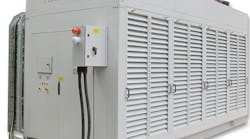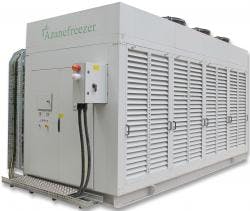Star Refrigeration Group of Scotland has established Azane, Inc. in San Francisco, CA, as a U.S. base from which it will market its low-charge ammonia freezers and chillers for the North American industrial refrigeration market. The systems will be manufactured in Chambersburg, PA.
The industrial refrigeration group, whose Azanechiller and Azanefreezer technology has been installed at some of the world’s leading organizations, developed the unique technology to meet the environmental and legislative challenges that the cooling industry was facing as Europe started the phaseout of refrigerant R-22.
Star Refrigeration says the technology is being introduced to the U.S. market at a key time, as the U.S. refrigeration industry begins to see the effects of the EPA’s R22 phaseout program. The EPA’s phaseout timetable for R-22 is to gradually decrease production until a complete ban comes into force in 2020. The cost of R-22 will continue to rise and existing R-22 refrigeration systems will become uneconomical long before the substance is banned completely.
The Azanechiller and Azanefrezeer are factory-built industrial refrigeration packages which are both highly efficient and environmentally conscious. The design uses patented technology to deliver the lowest cost of ownership by minimizing running costs over 25 or more years.
All Azane packages use the natural refrigerant ammonia, and have been designed to operate with as little as one-tenth of the charge of a traditional refrigeration system, therefore avoiding the burden of OSHA’s PSM and the EPA RPM requirements.
Star Refrigeration says ammonia is "future-proof," due to its being a natural refrigerant with environmentally friendly credentials — zero ozone depletion potential (ODP) and zero global warming potential (GWP) — and therefore not under threat of being banned, unlike HFCs.
“The good news is that there are plenty of options available to allow a smooth transition away from R-22," says Derek Hamilton, U.S. business development manager at Azane. "Low charge ammonia is one of a number of options available, and we're always happy to talk to our customers and guide them through the various options. There are a wide range of ‘drop in’ refrigerant options available, which typically consist of blends of hydrofluorocarbons (HFCs).”
“However HFCs have an uncertain future due to their contribution to global warming. The U.S.government has stated that a reduction in HFC consumption is one of the key targets in their plans to address climate change. While a firm timetable is yet to be published, it is only a matter of time before restrictions on the use of HFCs come into place as has already happen in Europe at the end of last year. Our approach is to look at the overall strategy of a business to ensure that they invest in the technology which is right for their needs”
With manufacturing facilities in Pennsylvania, the energy efficient packaged ammonia chiller and freezer are fabricated following U.S. standards and regulations, and supplied nationwide. Azane, Inc. also provides dedicated technical support, site surveys, proposals, and training to HVACR contractors, consultants, operators, and end-users.
Star Refrigeration reports Azane's air cooled chilling and freezing solutions offer an environmental solution with a low total life cycle cost in a number of applications including HVAC, food processing and freezing, process cooling, public refrigerated warehouses, ice rinks, and more.
The factory-built design of the Azane packages makes them suitable for new installations and upgrade projects. The packages require no machinery room and can be located close to the cooling demand, making the installation simple and low cost.
“In the USA, the use of ammonia has historically been restricted to large, distributed refrigeration systems," Hamilton says. "These systems are typically site-installed and require a central machinery room to house the refrigeration equipment. These systems also tend to use ‘pumped circulation’ technology which requires a relatively large quantity of ammonia.
“The advent of ‘low charge ammonia’ means that ammonia is now being considered in applications which were typically the domain of ‘commercial’ systems. These commercial systems often use the HFC refrigerants mentioned above. Some users of HFC systems may be reluctant to switch to an ammonia system because of safety concerns, however the reality is that ammonia systems in general are very safe and the low-charge, packaged approach alleviates these concerns further by using the minimum amount of ammonia and ensuring that it stays within the refrigeration system.”
For further information contact [email protected] or visit the website azane-inc.com.
Azanechiller range features 12 air and water cooled models with capacities from 200kW to 850kW.Azanechiller can cool both water and secondary fluids including glycol, making it suitable for a wide range of applications including TCS&D, HVAC, food processing, ice rinks and process cooling.
Azanefreezer has a very low charge of ammonia, as low as 0.9kg/kW (5lb/TR). Standard sizes range from 110kW to 250kW for a nominal cold store temperature of minus 25°C and from 25TR to 70TR for a nominal freezer temperature of minus 10°F.High efficiency control features include floating head pressure and EC condenser fans.Key benefits include low maintenance costs and no on-going water, effluent and water treatment costs.
- See more at: http://www.star-ref.co.uk/star/azane-cooling-is-natural-choice-for-tcsd-industry.html#sthash.kTlDhmgs.dpuf










